
How to Find the Best Social Media Management Tool
Professional social media management is demanding and labor-intensive. This already applies to companies that focus on just one channel. It’s time for a social media management tool at the latest if your team wants to provide content for several platforms and manage several communities. This allows you to keep an overview and manage all processes in one central location, from content marketing to community management. Many social media management tools also come with valuable functions that make work easier, workflows more efficient and ensure better results.
Which brings us to the crucial question: How do I find the right social media management tool? In this blog post, we want to help you make the right decision.
Why the choice is crucial
At first glance, many social media tools seem very similar.
So why not try one out instead of studying it?
There are several good reasons for this:
- (Small) differences can have big consequences: Every tool is different. But to what extent is often only revealed on closer inspection. Details determine whether your team can work as efficiently as it would like.
- Rash decisions can lead to integration problems: A wide range of functions won’t help you much if the software is difficult to integrate into your processes and systems.
- Not every tool is a long-term fit: We recommend that you look for software that also covers your future needs. Otherwise, you will have to switch in the event of changes or strong growth.
- Switching costs time and effort: Replacing one tool with another in your day-to-day work usually involves a lot of effort and expense. You can save yourself this if you choose the right one from the start.
So there are many arguments in favor of making a thorough comparison and making a careful decision.
Preliminary considerations
Before you start looking at tools, take a look at your social media strategy and define your needs and goals.
Answer the following questions:
What goals am I pursuing on social media?
Sie sehen gerade einen Platzhalterinhalt von Standard. Um auf den eigentlichen Inhalt zuzugreifen, klicken Sie auf den Button unten. Bitte beachten Sie, dass dabei Daten an Drittanbieter weitergegeben werden.
Weitere InformationenDo you primarily want to make your brand known or also generate leads and attract customers? What role do social customer service and community management play for you? How important is social media in your communication?
Several goals usually go hand in hand. In addition, almost all companies want to increase their reach with social media. However, it makes a difference whether you want to find influencers on social platforms or do employer branding on LinkedIn. The features that the tool should definitely have depend on the focus of your team. For example, to find influencers, place particular emphasis on monitoring.
Which channels do I want to be active on?
When answering this question, always assume where your target group is located. Also think about the future: maybe TikTok will be worth a try next year.
What resources do I have at my disposal?
How much money can you spend and how much (wo)manpower does your team have?
How many people should work with the tool?
How big is your team? Do you want to integrate external service providers into the communication?
What is your existing infrastructure like?
Which tools are you using and which ones do you want to use in the future? What requirements does this place on new software? Should your social media management tool completely or partially replace other software?
Social media management tool – key selection criteria
Once you have defined your initial situation, you can start comparing tools.
Pay particular attention to the following features:
Available channels
Use one social media management tool instead of several for all your platforms. Even if the latter seems cheaper at first, the additional effort quickly negates this advantage.
Ask yourself the following questions:
- Which platforms are currently important for my company or organization and which do I want to use in the future?
The answer depends above all on where your target group is located and what you want to achieve. In the B2B sector, a tool that can do LinkedIn is worthwhile; for an online fashion store or a furniture store, Pinterest is more than worth a look. And what about TikTok, Bluesky and Threads?
More is not always more. It’s better to concentrate on the most important platforms instead of being present everywhere and doing things by halves.
- Is the tool or its provider an official partner of the platforms?
If so, you can assume that you will benefit from all the network’s key functions in the long term. But not all platforms have a partner program at all.
- Can the activities in all channels be managed in a dashboard?
The more you and your colleagues have to “jump”, the more time-consuming the work is.
- Are there restrictions for certain channels?
In this context, it should be noted that some social media platforms do not “allow” certain functions to be carried out with social media management tools. For example, there is no interface for adding Instagram Story Stickers.
Caution: If a tool offers functions that the platform is not allowed to offer, this will not work via the official interface. You will then usually have to share your login details with the tool. Furthermore, the platforms don’t just take action against the tools themselves. They also block accounts that use them. It is therefore not a good sign if a social media management tool can do something that it should not be able to do. We recommend: Keep your hands off it!
Which functions are important?
Once you have clarified which channels you need, it’s time to look at the functions.
There are two groups here:
- Basic functions: Your social media management tool should have some features in any case.
- Additional functions: Other functions are not a must, but can prove to be a valuable asset, depending on your needs.
The following functions are among the must-haves:
Scheduling, creating and publishing posts
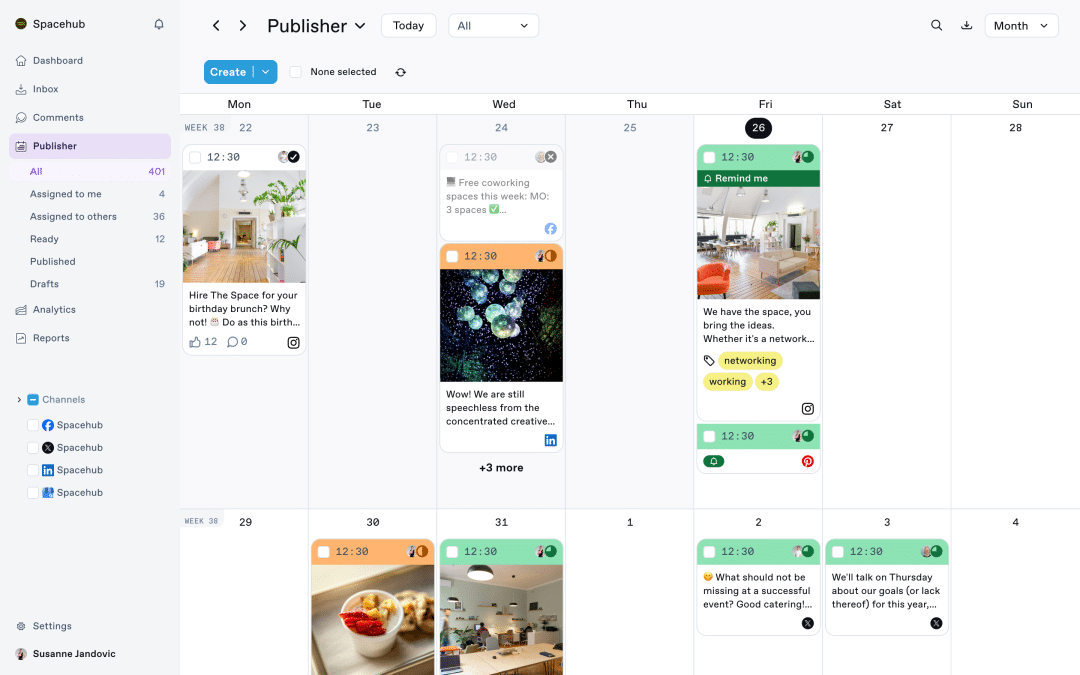
For professional content marketing on more than one platform, you need a social media management tool with an editorial plan.
But not all editorial plans are the same. Don’t just make sure that social media posts can be created, edited and scheduled for automatic publication as a team. Duplicating posts across channels can also save you a lot of time.
Ideally, you should have various post formats at your disposal, including videos, stories and posts with more images. Some tools are also equipped with image editing functions. This means you can directly adjust images for Facebook, Instagram or Pinterest and even make them a little prettier – without having to use an external image editing program.
It also makes a difference how well you can communicate with colleagues in the tool when creating and checking content, keyword: feedback.
Social engagement
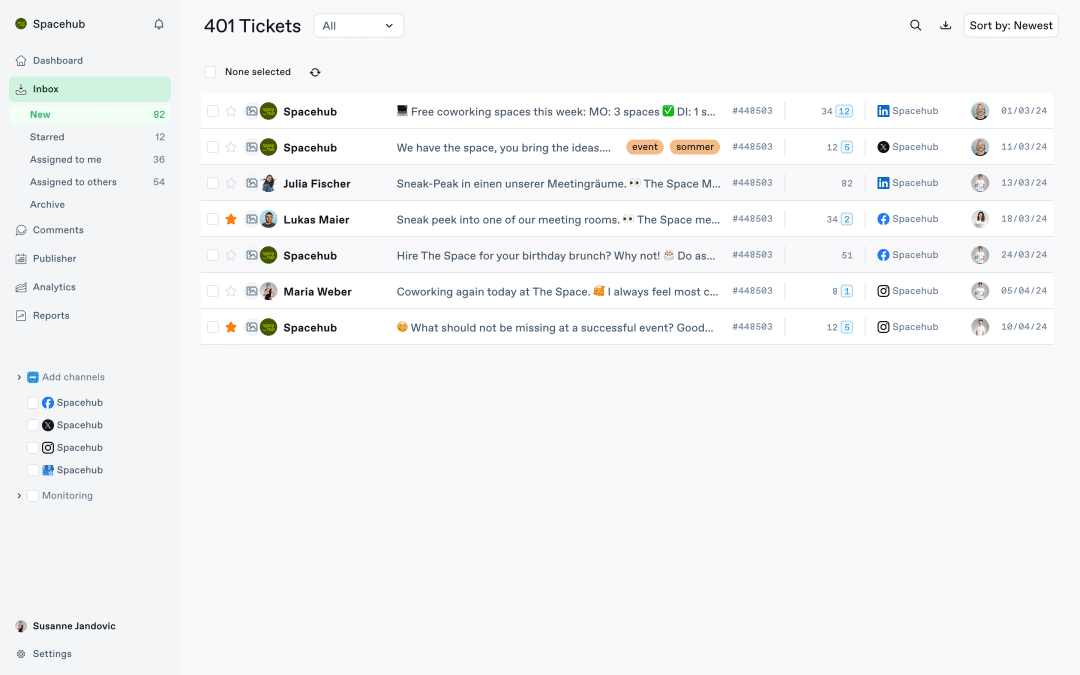
Community management is usually just as important as content marketing. The big advantage of a good social media management tool is that your team can handle interaction on all channels in one tool and always have a complete overview.
With a good social media management tool, you can find all comments, posts, mentions and direct messages in one central location. Pay attention to whether tickets are created at post or comment level. One option is probably more convenient for you than the other. A particularly important community management function is the easy forwarding of tickets to colleagues or other departments. It is also helpful if you can set up custom notifications. This makes it easier to react quickly, for example to nip an impending shitstorm in the bud.
Content is king. Download our free check list “7 Steps for Social Media Content Your Audience Will Love” now and find out how to create content that inspires your target group.
Social media analytics
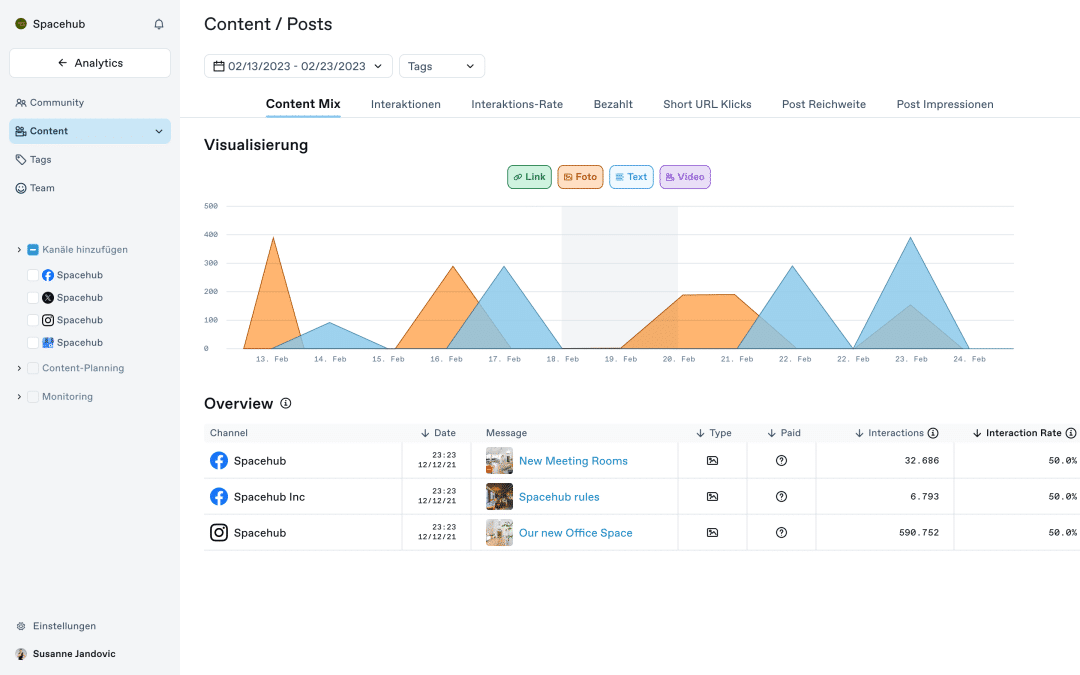
- What key figures does the tool offer you? At this point, go back to your goals and record which key figures are decisive for you.
- How does it prepare the key figures? After all, nothing beats meaningful graphics.
- What options do you have for creating individual reports? This function is extremely important for presenting your team’s successes to superiors and/or customers. Here, too, visually appealing graphics outperform Excel tables.
- Are there additional functions such as a sentiment analysis that gives you a picture of the mood towards your brand, products or competitors?
Monitoring
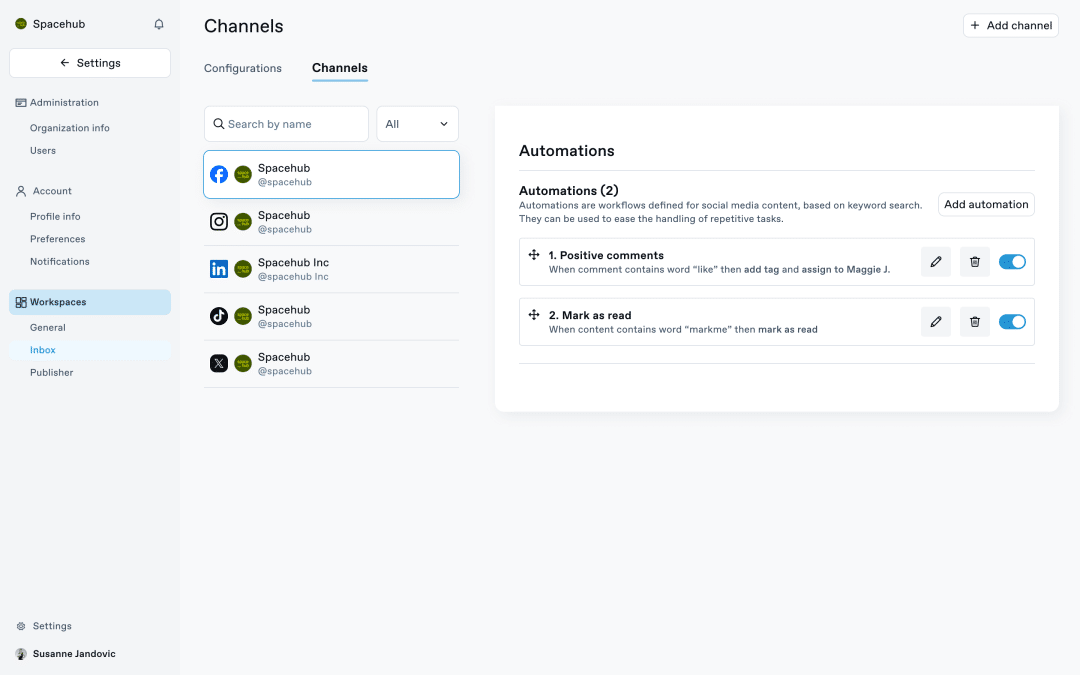
Save yourself a separate monitoring tool by letting a social media management tool do the work for you. Ideally, you will be able to track mentions of your brand or your products by competitors or other important topics in social networks and detect trends with social listening.
Tip: Take a look at the languages in which web monitoring works. Especially if your company or organization operates internationally, it is important to stay up to date internationally.
AI functions
Artificial intelligence has long since arrived in social media marketing. With the right AI functions, you can save a lot of time on repetitive tasks, prevent errors and promote creative processes.
For example, AI tools that write or rewrite texts for different platforms based on prompts or keywords are very helpful. In community management, you benefit when artificial intelligence hides potential spam or hate comments.
How does working in a team look like?
You will probably not be doing social media marketing on your own, but as part of a team. When selecting a tool, it is therefore advisable to pay particular attention to how it promotes or facilitates teamwork.
Important points here are:
- What options do you have for configuring approval processes?
- How easy is it to collaborate with agencies, business partners and the like from within the tool?
- How easy is it to take over when one person is not present?
- How well does internal team communication work in the tool?
Many of these questions can be answered better in practice than in theory. We’ll come back to this later.
Integrations
No social media management tool can do everything you need for your work. That’s why it’s practical if you can access other software directly in your tool.
A good example is a link to a design tool such as Canva. This gives you the option of accessing your designs in your social media management tool and using them for new posts. Exporting and importing is no longer necessary.
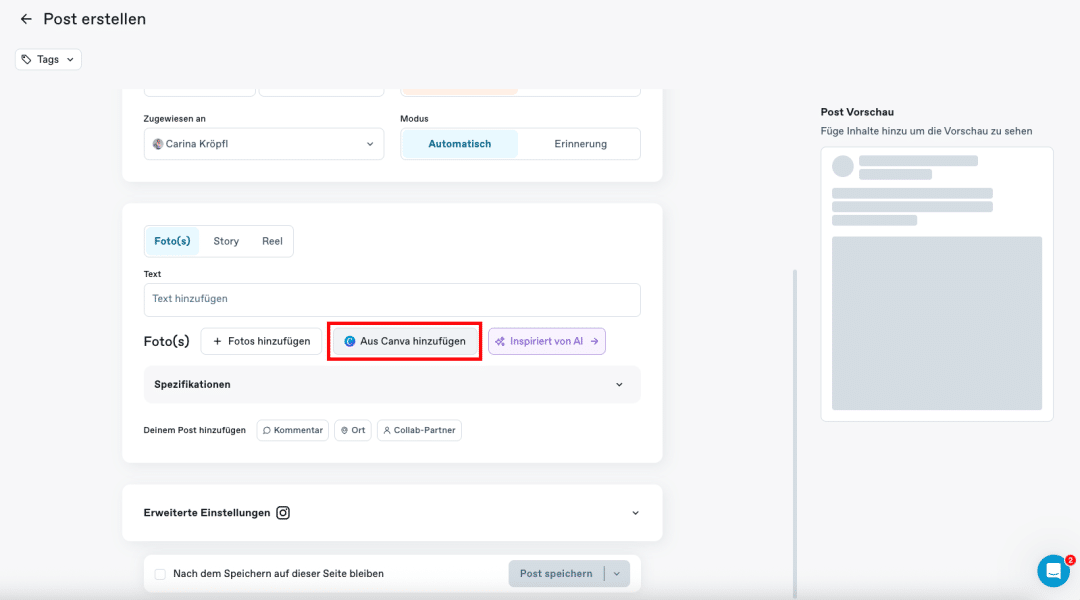
Security
Don’t forget about security. After all, you are entrusting your tool with valuable data. If something goes wrong, your company’s reputation is at stake.
But how can you tell whether a provider is serious about data protection?
Pay particular attention to the following features:
- Certifications, for example to ISO 27001, prove that a company meets high data security standards. Regular audits by external certification bodies are necessary to obtain and maintain these standards.
- If data is stored on European servers, this is another positive sign.
- Find out which authorization systems are available to you. Can you ensure that only authorized persons can access sensitive information and make posts?
- The tool should use official APIs for connections to social media platforms.
Constant development and updates
The social media world is fast-moving. It is therefore important that your tool is regularly adapted to new requirements. This includes offering new functions and serving additional platforms. A look at a changelog will give you an initial feel for this.
Costs
The costs of social media tools vary greatly and depend on factors such as the range of functions.
Important differences are:
- Monthly vs. annual costs: Many providers grant discounts for annual billing. This is why an annual subscription is usually worthwhile.
- Cost per user/month: Sometimes tools are billed per user, others have package prices for a certain team size.
- Service packages: Perhaps you only want to use your tool for certain tasks? Then it may make sense to book a slimmed-down version.
- Additional costs: Pay attention to possible additional costs for additional modules, number of brands or channels, support or training.
Estimate the costs you will incur for manual processes and external service providers that a tool replaces. Also consider the time saved and the profit from potential new leads and customers. This will give you an initial idea of the maximum cost of your tool.
Stability and profitability of the tool provider
Admittedly, this point is not the most obvious. On the other hand, it is very smart to scrutinize the provider from an economic perspective – especially if you are paying for a tool twelve months in advance. Try to find online data on the company’s turnover and profit. A slow but steady increase in the number of employees indicates stable growth. This reduces the risk of choosing a tool that may no longer exist in six months’ time.
Start-ups that grow quickly through investments are not automatically no-goes. But be aware that sudden changes of course are not uncommon here. An established provider with years of experience usually offers fewer unpleasant surprises.
Support and user-friendliness
If you have any questions or problems, fast, competent support is crucial. Of course, it is ideal if it is available in your language and around the clock. Pay attention to the availability of live support (live chat).
The following also applies: The most powerful tool is worth little if it cannot be operated. User-friendliness ensures fast, efficient processes and a better mood for everyone involved.
Compare, test, then decide
Choosing a social media management tool is not necessarily a decision for life, but in case of doubt, it is a decision for half a lifetime or at least many years. So take your time with it. Compare reviews of different tools on platforms such as OMR Reviews, Capterra, or G2.
Professional social media management tools usually offer a free trial version. Take advantage of this opportunity and test the tool extensively as a team. Check how well it fits in with your workflows and working environment. Pay particular attention to the aspects listed above.
We have created a checklist for you to help you keep an overview when searching for the right tool. You can also download the print version here.
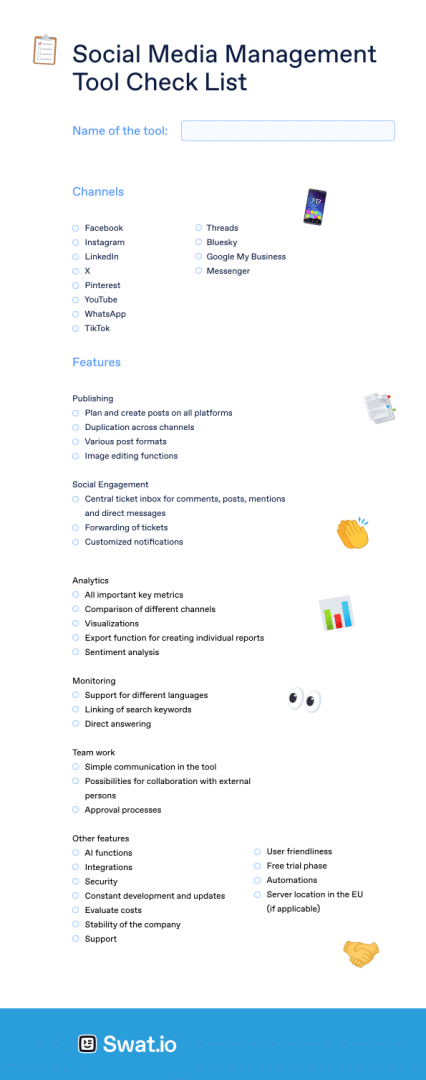
Why search long and hard when the good stuff is so close? Swat.io offers you a wide range of functions for social media management, from content planning and publishing to community management, customer service and analysis. Try it out now and start a free trial!
 20. May 2025
20. May 2025 







